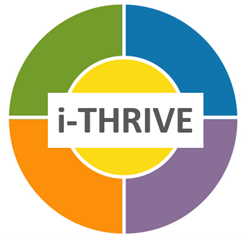i-THRIVE
Working together to promote the emotional and mental wellbeing of children and young people
Why change is needed
Most children and young people have good emotional and mental wellbeing, but there is growing evidence of increasing needs and risk factors for poor mental health. Requests for services in England have more than doubled since 2018, but only 32% more patients are being seen compared to March 2021. Young people in Cheshire East have highlighted mental health as a major concern that needs more attention and investment. But, we cannot meet these needs by simply asking staff to work harder.
We need to think differently and foster partnerships between education, health, social care, and the third sector. This issue should not be left to individual services with limited capacity.
To achieve this, we need a common language to understand signs of distress, mental health needs, and service thresholds.
This approach should be based on evidence of what works in promoting the mental health and wellbeing of all children, including those who do not need individual support and those who would benefit from targeted assessment, advice, and support.
Introducing i-THRIVE
We believe that implementing the THRIVE Framework for system change (PDF, 5MB) will enable the childrens services to move away from a tiered system of services for children and young people’s mental health to one that can organise care around the needs of children and young people.
The THRIVE framework relates to:
- All children and young people aged 0–25 within a specified locality, and their families and carers.
- professionals from various sectors( education, social care, voluntary, health) who work to promote mental health awareness and help children and young people with mental health and wellbeing needs or those at risk of mental health difficulties.
What the THRIVE Framework means for children and young people
- No ‘wrong door’, meaning that anyone that a child or young person talks to about their mental health, whether they are a teacher, a GP or school lunchtime assistant, are able to provide them with support, or at the very least, signpost them to available support options.
- Whoever is helping a child or young person with their mental health knows the best ways to ask for their views about what is important to them and what they want to be different, so that there is genuine shared decision making about ways of helping.
- Signposting the child or young person, and their family and friends, to ways that they can support their mental health and wellbeing needs.
- Whoever is giving a child or young person more specialised mental health help will support the child or young person to evaluate their progress towards their goals and check that what is being tried is helping.
- Supportive and transparent conversations about what different treatments are likely to lead to, including their limitations.
More information about the THRIVE Framework can be found by visiting: i-THRIVE overview summary leaflet (PDF, 5MB) or the following the i-THRIVE animation.
Professionals working together
Cheshire East are calling on all professionals working with Children and Young People to work together in order to:
- improve interagency working and collaboration
- increase shared decision making with children and young people
- develop a wider and more diverse offer of help and support for children and young people across the system
- reduce silo working and the boundaries between services to reduce the likelihood of children falling through the gaps
- reduce wait times for children and young people
- increase collaboration with young people as part of service redesign
Engagement events
We are hosting three in-person cross-sector engagement events for all system partners. For more information and to book a place go to the i-THRIVE engagement events page.
i-THRIVE training
We’re offering free training in i-THRIVE academy modules to help colleagues from different sectors work better together.
Page last reviewed: 17 September 2024
Thank you for your feedback.